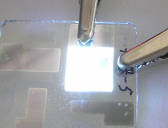A common mechanism underlying charge traps in organic electronics has been discovered,leading to a theoretical framework for improved plastic electronics,OLEDs and organic solar cells.
During their passage through semiconductors,a proportion of electrons get stuck in charge traps and are no longer useful-dropping the efficiency of OLEDs for example.
"This trapping process greatly reduces the electron current and moves the location where electrons are converted into photons away from the centre of the device,"said the team-from the University of Groningen and the Georgia Institute of Technology.
Although various mechanisms have been proposed to explain such traps,no one knew for sure what they are.
"We set out to solve this puzzle by comparing the properties of these traps in nine different polymers.The comparison revealed that the traps in all materials had a very similar energy level,"said Herman Nicolai,first author of a paper on the subject in Nature Materials('Unification of trap-limited electron transport in semiconducting polymers').
The Georgia Tech group,led by Jean-Luc Bredas,modelled electronic structures in a wide range of possible traps.
"What we found out from the calculations is that the energy level of the traps measured experimentally matches that produced by a water-oxygen complex,"said Bredas.
Although the devices studied by Nicolai were fabricated in a nitrogen atmosphere"such a complex could easily be introduced during the manufacturing of the semiconductor material,even if this is done under controlled conditions.Nitrogen cannot prevent contamination with minute quantities of oxygen and water",he said.
As traps are now know to have a similar energy level,the electron current in different plastic materials can be estimated,and it may be possible to design trap-free materials.
"The trap energy lies in the forbidden energy gap,"said Nicolai-the gap which represents the difference in energy of the outer shell in which the electrons circle in their ground state,and the higher orbital to which they need to be moved to become mobile charge carriers.
When such a mobile electron runs into a trap that is within the energy gap,it will fall in because the trap has a lower energy level.
"But if chemists could design semiconducting polymers in which the trap energy is above that of the higher orbital in which the electrons move through the material,they couldn't fall in.In this case,the energy level of the trap would be higher than that of the electron,"said Nicolai.With both plastic LEDs and plastic solar cells,"the electron current should not be hindered by charge trapping.With our results,more efficient designs can be made".
Experimental work was done in the Zernike Institute of Advanced Materials(ZIAM)at the faculty of Mathematics and Natural Sciences,University of Groningen,the Netherlands.
The theoretical nature of the trap was identified at the School of Chemistry and Biochemistry and Center for Organic Photonics and Electronics at the Georgia Institute of Technology.





